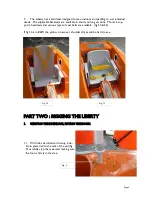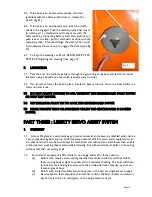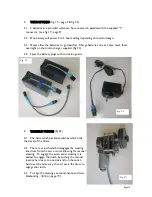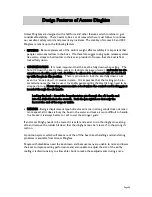
Page 19
the console starboard side close above the battery compartment
8.4 If components are swamped remove and dry them first if necessary, then spray with
“Corrosion Guard”
8.5 Remove the inspection ports to ventilate the buoyancy compartment when the boat is
packed away each day.
8.6 When the boat is stored for extended periods, remove (all) the electrics completely, ser-
vice them and store in a dry place.
8.7 If the boat is usually sailed manually, remove the electrics till they are needed again, closing
all the holes with rubber bungs.
8.8 If the main sheet winch fails to work when activated first check the plug leads. If all seems
OK next listen at the control box to hear if the relays are clicking. If they are the problem may
be the blown fuse taped onto the side of the mainsheet motor which is in the circuit to protect
the components if the sheet winch motor is stalled and overloaded. Remove the winch, re-
move the tape and replace the 10 amp x 12 volt fuse.
8.9 If the MO switch fails to engage and disengage the jib winch it is most probably dirty termi-
nals in the 9 pin joystick connectors. Clean with a Do not spray the 9 pin connectors with
corrosion guard as the MO switch works with mille amps and corrosion guard will inhibit a
good contact.
8.10 Adjusting the steering lines. To align the steering, engage the clutch, rotate the drum from
lock to lock, then stop it at what you estimate to be the mid point. There are steering line ad-
justments at the tillers and at the joystick. Adjust the lines so that the joystick, tillers and the
winch drum are all central. When you run the motor look for the tillers to oscillate evenly
port and starboard, and that the joystick oscillates correspondingly. If not adjust the lines till
they are.
8.11 If the sheet is accidentally run through the winch, remove the winch, rotate the threaded
rod to release the rocker until the sheet can be fed back around the drum, then re-tension the
sheaves by rotating the rod. Reinstall the winch. If the rope slips it could be that more sheave
tension is needed, so adjust the threaded rod, or possibly the glass beads are worn. Contact
us in this event.
8.12 Changing between manual and servo a assist systems.
(a) If you wish to sail the boat manually and adjust the sheets by hand, wind the sheets
out of the winches leaving a tail of about half a meter outside the winches. This will
leave the full length of the sheets available for manual operation.
(b) To change back to servo assist winch operation reverse the above process and wind
the sheets in on the winches leaving about half a metre outside the camcleats. This
will leave all the sheet available for servo use.
(c) To align the main and jib sheet winches to work in sinc refer to Part Two – Rigging
the Liberty, 3 Setting up main and jib sheets.
The Recommendations relating to corrosion should be taken very seriously and apply to any en-
vironment, but the warmer and more humid your climate the more vigilant you will have to be.
IF YOU SAIL IN SALT WATER YOU SHOULD TAKE THESE RECOMMENDATIONS VERY
SERIOUSLY.

















